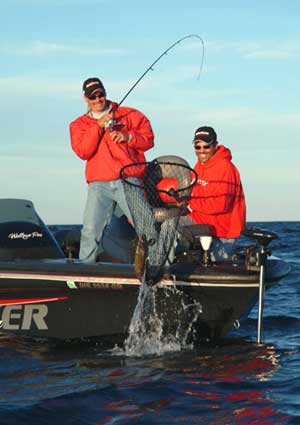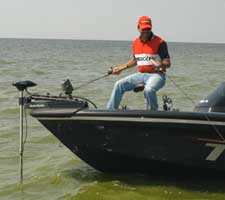
Over the years there have been numerous so-called “secret tactics of the Pros” that have popped up in the walleye world. For instance, the slip-sinker live bait rig was one of those early tactics that only a select handful of Minnesota guides used to coax tight lipped ‘eyes from deep summer structure. That was until a pair of brothers from Chicago made a few small refinements to the technique, shared it with the angling world, and eventually built an empire known as The In-Fisherman from that foundation. OK, so that’s simplifying the story a bit, but you get the idea; most popular fishing techniques started out as a “secret” some where along the line, but like most “secrets” in fishing, they don’t stay secret for ever.
One such “secret” tactic that has been getting a lot of attention the past year or so is one that we’ve been having great success with in all sorts of livebait rigging situations. It’s called “Slow Death Rigging”. It’s one of those techniques that anglers “in-the-know” have been utilizing but keeping under wraps for several seasons now. Credit for the presentation goes to a South Dakota guide and tournament angler, Dave Spaid. It’s said that Dave would observe the small smelt that would get caught up in the turbines coming through the Oahe Dam; they would then come rolling and flickering down the current – an easy meal for waiting walleyes and other predators. Through trial and error, he discovered that a short piece of crawler on a bent Aberdeen-style hook immitated the “Slow Death” of these smelt as they washed downstream.
The key to the Slow Death presentation is the hook. The problem was to get the hook-bend just right so the bait would spin consistently. In the past, we’d take a size #2 Mustad Aberdeen hook and with much experimentation trying various “bends” in the hooks we finally got a design that gave us the action we were looking for. Once we had the hook bend figured out, we took the idea to Mustad and asked if they’d produce a hook with the specific design we had developed. They jumped on the idea, and we now have a factory made hook specifically designed for the Slow Death presentation. Mustad’s Slow Death Hook model 33862 comes in 3 finishes, red, bronze and gold, and has the perfect bend to give the action needed to make this presentation work.
The Slow Death tactic is most often fished as a modification of the bottom bouncer-live bait rig. From the bouncer, run a 3 to 4 foot leader of 10-pound test Berkley 100% Fluorocarbon then tie on the Slow Death Hook. To properly rig the hook, thread a nightcrawler up the hook right up over the eye and knot, then pinch off the tail end of the crawler leaving about a half inch dangling off the back of the hook.
This rig has proven deadly in many of the same scenarios where you’d run a bottom bouncer spinner combination. For instance, situations when walleyes are scattered across main-lake flats or feeding shelves on points in depths of 12 to 25 feet, or possibly when walleyes are relating to specific structure such as a channel edge or even deep weed edges. As far as how fast to run the rig, you want to move along a little slower than the speed you would when running spinners; in the ½ to ¾ mph range or just fast enough to get the hook and bait spinning seductively in the water. The Slow Death rig is a presentation that lends itself well to situations where you need to cover water but want to do it with a “power finesse” attitude.
 The bouncer weight is also an important key to success with the Slow Death rig. The same principals apply here as they do when spinner fishing; you want the bouncer running at about a 45 degree angle from the rod tip, and just ticking bottom. In most cases, a 1 and 1/2 ounce bouncer will be the choice in depths from 12 to 20 feet, a 2 ounce bouncer from 20 to 30 feet, and so on.
The bouncer weight is also an important key to success with the Slow Death rig. The same principals apply here as they do when spinner fishing; you want the bouncer running at about a 45 degree angle from the rod tip, and just ticking bottom. In most cases, a 1 and 1/2 ounce bouncer will be the choice in depths from 12 to 20 feet, a 2 ounce bouncer from 20 to 30 feet, and so on.
Using the right equipment is always important to get the best results with any walleye fishing technique, and the Slow Death tactic is no exception. The rig is typically fished in one of two ways; on a hand-held rod and on a rod set in a rod holder. For the hand-held rod, a 6 foot 6 inch medium action bait cast rod and a reel spooled with a quality low-stretch line like 12 pound test Berkley Sensation or 10 pound Trilene XT is ideal. Lines like this will give you plenty of “feel” to know you’re ticking bottom and to feel bites. They’re also highly abrasion resistant which helps since many times you’re fishing these rigs around rocky, snag filled areas. Setting the hook with a Slow Death rig is also much the same as when fishing with spinners. When you feel the bite, drop the rod tip back to the fish and then set the hook by sweeping the rod forward. Since the bait is a relatively small target, short hits are rare. If you find you are missing fish however, that’s a good indication that the fish may not be very active and you may need to slow down and possibly go with a more standard live bait presentation.
On lakes where fishing with 2 rods is legal, you can also fish a rig on what is often referred to as a “Dead Stick”. This is usually a longer rod, 8 and a half to 12 feet long, with a softer, medium light action. The length of the rod allows you to cover more water than with just the hand-held rod, and the softer action of the rod allows a fish to grab the bait and feel little resistance until it’s already hooked up. Keith Kavajecz and I have designed a full line of bottom bouncer and Dead Stick rods for the Walleye Angler Signature Series for Bass Pro Shops. These are rods designed specifically for these types of presentations.
There will never be a secret bait or tactic for catching walleyes in every situation all the time, but the Slow Death rig is continuously proving to be a versatile and productive technique the more and more it’s utilized. It’s a tactic that fills a void between bouncers and spinners and the traditional live bait rig and could dramatically increase your walleye fishing success this upcoming season if you add this to your bag of tricks.










